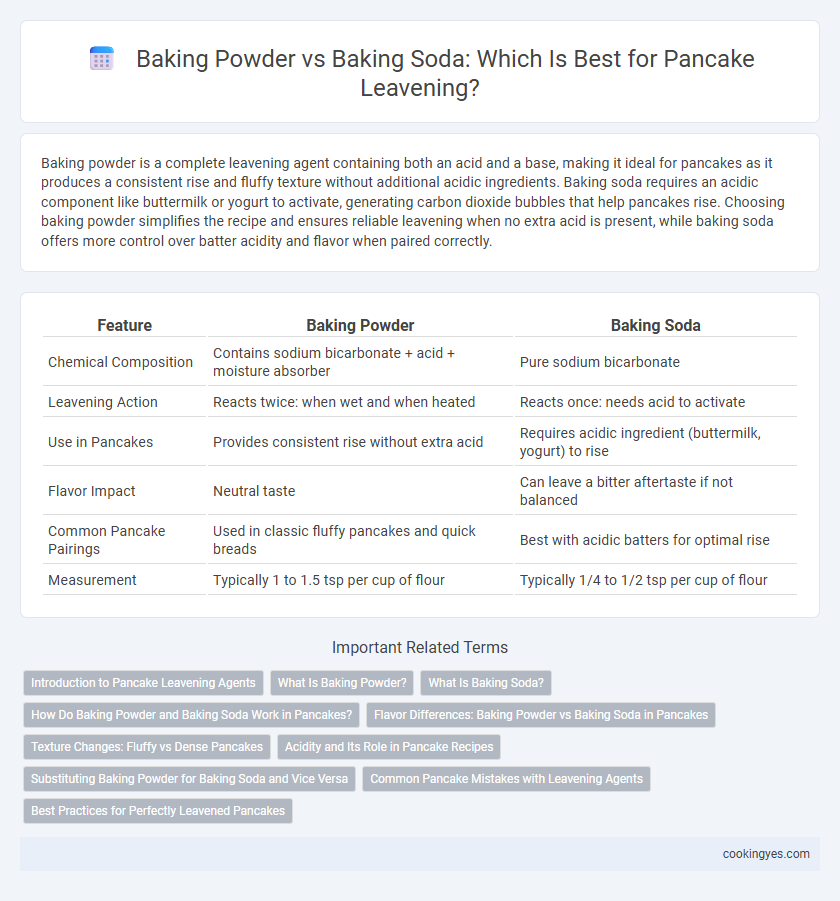Baking powder is a complete leavening agent containing both an acid and a base, making it ideal for pancakes as it produces a consistent rise and fluffy texture without additional acidic ingredients. Baking soda requires an acidic component like buttermilk or yogurt to activate, generating carbon dioxide bubbles that help pancakes rise. Choosing baking powder simplifies the recipe and ensures reliable leavening when no extra acid is present, while baking soda offers more control over batter acidity and flavor when paired correctly.
Table of Comparison
| Feature | Baking Powder | Baking Soda |
|---|---|---|
| Chemical Composition | Contains sodium bicarbonate + acid + moisture absorber | Pure sodium bicarbonate |
| Leavening Action | Reacts twice: when wet and when heated | Reacts once: needs acid to activate |
| Use in Pancakes | Provides consistent rise without extra acid | Requires acidic ingredient (buttermilk, yogurt) to rise |
| Flavor Impact | Neutral taste | Can leave a bitter aftertaste if not balanced |
| Common Pancake Pairings | Used in classic fluffy pancakes and quick breads | Best with acidic batters for optimal rise |
| Measurement | Typically 1 to 1.5 tsp per cup of flour | Typically 1/4 to 1/2 tsp per cup of flour |
Introduction to Pancake Leavening Agents
Baking powder and baking soda are essential leavening agents in pancake recipes, each functioning through distinct chemical reactions to create the desired fluffy texture. Baking powder contains both an acid and a base, producing carbon dioxide bubbles when moistened and heated, making it a complete leavening system ideal for pancakes without acidic ingredients. Baking soda requires an acidic component, such as buttermilk or yogurt, to activate and release carbon dioxide for rising, influencing both the texture and flavor of pancakes.
What Is Baking Powder?
Baking powder is a leavening agent commonly used in pancake recipes, consisting of a combination of baking soda, an acid component, and a drying agent like cornstarch. It releases carbon dioxide gas when mixed with wet ingredients, causing the pancake batter to rise and create a light, fluffy texture. Unlike baking soda, baking powder contains its own acid, making it ideal for recipes that do not include acidic ingredients.
What Is Baking Soda?
Baking soda, also known as sodium bicarbonate, is a white crystalline powder used as a leavening agent in pancake recipes. It reacts with acidic ingredients such as buttermilk or yogurt to produce carbon dioxide gas, which causes the batter to rise and creates a light, fluffy texture. Unlike baking powder, baking soda requires an acid to activate its leavening properties, making it essential to balance the recipe's pH for optimal pancake fluffiness.
How Do Baking Powder and Baking Soda Work in Pancakes?
Baking powder contains both an acid and a base, releasing carbon dioxide gas when mixed with wet ingredients, which creates a light and fluffy texture in pancakes. Baking soda requires an acidic component like buttermilk or yogurt to activate and produce bubbles that help pancakes rise. Using baking powder simplifies the leavening process, while baking soda offers stronger lift but depends on acidic ingredients for effective leavening.
Flavor Differences: Baking Powder vs Baking Soda in Pancakes
Baking powder enhances pancake flavor with a mild, slightly tangy taste due to its balanced acidic and alkaline components, promoting a tender crumb. Baking soda produces a distinct alkaline flavor and can impart a soapy or metallic aftertaste if not neutralized by sufficient acidic ingredients. Choosing baking powder ensures consistent pancake flavor and texture, while baking soda requires careful acid balance to avoid altering the pancake's natural taste.
Texture Changes: Fluffy vs Dense Pancakes
Baking powder creates fluffy pancakes by releasing carbon dioxide during both mixing and cooking, ensuring a light and airy texture. Baking soda requires an acidic ingredient to activate and, if not balanced properly, can produce denser pancakes with a slightly metallic taste. Using baking powder provides more consistent rise and softer crumb compared to the denser, heavier texture often resulting from baking soda-only leavening.
Acidity and Its Role in Pancake Recipes
Baking powder contains both an acid and a base, allowing it to react and produce carbon dioxide bubbles for leavening without additional acidic ingredients in pancake recipes. Baking soda requires the presence of an acid such as buttermilk or yogurt to activate its leavening power and ensure proper rise. The acidity level in the batter directly impacts the texture and fluffiness of pancakes by controlling the chemical reaction speed and gas release.
Substituting Baking Powder for Baking Soda and Vice Versa
Baking powder contains both an acid and a base, allowing it to leaven pancakes effectively without additional acidic ingredients, while baking soda requires an acid like buttermilk or yogurt to activate its leavening properties. When substituting baking powder for baking soda, use about three times the amount since baking powder is less concentrated. Replacing baking powder with baking soda demands adding an acid to the batter to achieve proper rise and avoid a metallic taste.
Common Pancake Mistakes with Leavening Agents
Using baking powder instead of baking soda in pancakes is a common mistake that affects texture and rise; baking powder contains both acid and base, allowing it to leaven without additional acidic ingredients. Relying solely on baking soda without an acid can result in dense pancakes with a metallic taste due to incomplete chemical reactions. Proper measurement and understanding of each leavening agent's role prevent flat, tough pancakes and ensure a fluffy, tender batter.
Best Practices for Perfectly Leavened Pancakes
Using baking powder for pancakes ensures even leavening by releasing carbon dioxide gas twice--once when wet and again under heat--resulting in fluffy, tender pancakes. Baking soda requires an acidic ingredient like buttermilk or yogurt to activate properly, preventing a soapy taste and promoting rise. Balancing the correct leavening agent with appropriate acidity and fresh ingredients creates perfectly light pancakes with optimal texture.
Baking powder vs baking soda for pancake leavening Infographic

 cookingyes.com
cookingyes.com